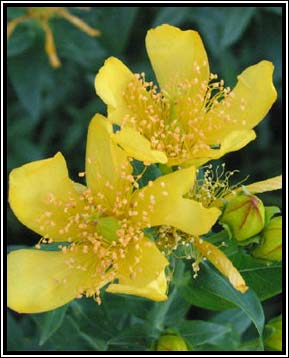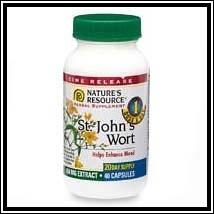|
ECOLOGY
St. Johns Wort is very easy to spot with bright yellow flowers with five petals, possessing narrow pale green elliptical shaped leaves. Size varies but can grow to be 32 inches tall! It usually blooms from July to early August, reproduces by short runners and by seed(Everett 1997). The drug consists of whole, or cut dried flowering tips and can be administered through cut and dried herb, herb powder, fluid and solid preparations for oral use and fluid and semi-solid preparations for external use. Depending on preference it can be used in salves, capsules, tinctures, capsules, pastilles, infusions, plaster or poultices.
Half of the states in North America are home to St. Johns Wort, including Oregon, California, Colorado and Montana. Within those states it is found along streams, in fields, and grasslands, pastures thrives along roadsides and in burned over areas. It is considered an invasive weed mostly due to its toxicity if ingested by cattle, and because its roots take a very strong hold when introduced to an ecosystem.
|
|
HISTORY
Hypericum perforatum is said to have been named by Saint John the Baptist because St. Johns Wort is generally collected on St. Johns Day, June 25. Native Americans used this herb for a variety of ailments. The Cherokees used it to bring on menstrual periods and as an anti-diarrheal, and the Montagnais Indians used it as a cough medicine. Most well known for its use in treating mild depression, it is commonly prescribed in place of Prozac for those who prefer homeopathic medicine. There are several groups of activists investing time in researching this plant due to the late media craze of it and thus its growing demand. New Market Research a biotechnology company is currently touring in Africa to monitor large scale cultivation of St. Johns Wort (Everett 1997). |
HISTORY
Historical uses of cattail species are vast and varied. The Cahuilla Indians of California used the stalks for matting, bedding material, and ceremonial bundles. The leaves and sheath were often used for caulking materials. The Apaches used the pollen in female puberty ceremonies. They used the spike as a torch after dipping it in coal oil. The fluff was used as tinder, insulation, and baby beds. The cattail’s versatility also shines in its historical use as a buoyancy tool. Air pockets in the stems made them a perfect material for cordage, used in the construction of tule boats (Murphy, 1959).
As a subsistence resource, cattail species have been a vital resource in Native American life. All parts of the plant are edible if gathered during the appropriate season. The young flower stalks, when taken out of their sheaths, can be boiled or steamed like corn. During the spring, the young shoots can be cut from the rhizomes when it is about 4-16 inches long. The rhizomes themselves are sweet in flavor and can be eaten raw, baked, roasted, or broiled. The base of the stem, initially attached to the rhizomes, can be boiled or roasted like potatoes (Harrington, 1972). Cattail pollen can play an important role in baking, as it can be used as a flour substitute. The pollen’s yellow color also gives foods a decorative yellow tinge. (NRCS).
|
|
ECONOMICS
This plant is a huge export commodity as well as a beneficial import. Many countries including the U.S. are growing it and exporting it. Germany is the leading exporter of it and the US is next in line. The average cost ranges from $13.00 (100 capsules 1-2 pill per/day.) to $17.75 (80 capsules 1-2 pills/day.), making it much less expensive than Prozac. St. Johns Wort goes for around $13.oo/month where as Prozac costs $75.00/month. There are two markets for this herbal medicine. One is the commercial market and the other is the domestic market, and prices are highly variable between the two.
MANAGEMENT AND POLICY
St. Johns Wort is subject to the same regulations that other medicinal NTFPs are. When a plant is proven to have healing properties, before it can be administered to the public, it must be applied to the Food and Drug Administration to be reviewed. This is often a costly and lengthy process, not to mention complicated. St. Johns Wort has made it through this process and has become one of the most important healing plants in treating depression. Another set of regulations that herbal products are subject to is through the American Herbal Products Association which has a code of ethics that each producer must follow. These ethics are in existence to promote the manufacture of high quality herbal products.
*Compiled from a paper by Julia Huxtable |
|


